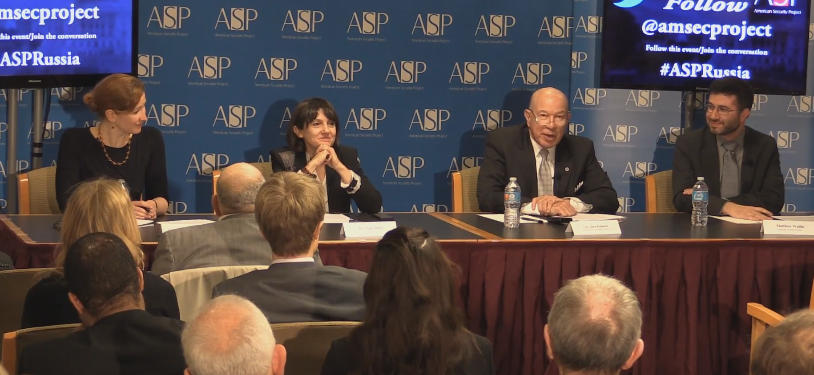
Event Recap: US – Russia Nuclear Policy in the Trump Era
Podcast: Play in new window | Download
Subscribe: Apple Podcasts | RSS
On February 28th, the American Security Project hosted an in-depth panel discussion on “US – Russia Nuclear Policy in the Trump era.” The panel included Col. Guy Roberts, USMC (ret.), an independent consultant on national security and proliferation and former Deputy Assistant Secretary General for WMD’s at NATO; Olga Oliker, senior adviser and director for CSIS’s Russia and Eurasia program; and Dr. Anya Loukianova Fink, Stanton Nuclear Security Fellow at the RAND Corporation. The discussion was moderated by ASP’s Fellow for Public Diplomacy Matthew Wallin.
Col. Roberts opened the discussion by highlighting the trend of increased threats posed to the NATO alliance by Russian nuclear capabilities and the recent uptick of aggressive Russian military posturing. From the outset of the creation of NATO’s ‘Strategic Concept’, published in 2010, the NATO – Russian relationship was described as a strong and productive partnership based on mutual confidence, transparency and predictability, though Col. Roberts pointed out that this former characterization is no longer the current reality. These new tensions coincide with the importance stressed by NATO allies on their reliance of the nuclear umbrella provided by the United States. The on-going strategic uncertainty not only reinforces the importance of a measured and reliable structure of nuclear assurance, but also strong and proactive leadership from the United States within the NATO alliance.
Dr. Oliker’s insight and discussion delved into the nature and history of Russian nuclear policy and force posturing. After Russia inherited the former Soviet-nuclear arsenal, there was a substantial internal debate over the former Soviet Union’s hard policy of “No first use” of nuclear weapons. Dr. Oliker explored the conventional force versus nuclear force argument within Russia, analyzing the effects of internal debate on the likely trajectory of Russian military policy. 2014 brought increased Russian brinkmanship and aggression, but Dr. Oliker believes that the nature of overall Russian strategy does not emphasize nuclear deterrence as a primary means.
Dr. Fink stated she believes the United States and Russia are both at a nuclear strategic crossroads. The opportunity presented by the Obama administration’s attempt at establishing a true partnership on nuclear materials, though ultimately an overall failure, laid the potential groundwork for a more effective atmosphere of continued nuclear cooperation. The decline of the US’s ability to compete in exporting nuclear reactors and in providing fuel-cycle services has made it apparent that the US must make substantial investments in terms of domestic, peaceful nuclear usage. Dr. Fink concluded that the ultimate goal should revolve around the role of statesmen and policy in continued constructive and positive conversation between the US and Russia.
Matthew Wallin began the open Q&A section with a question posed to the panel as to the best bilateral route to create more predictability and less uncertainty to help deter increased nuclear escalation. Failures in communication, increased verification mechanisms, the New START treaty, and a decrease in fissile nuclear stockpiles were all discussed as potential and successful avenues at decreasing this potential escalation.
See the full video of the event below:





